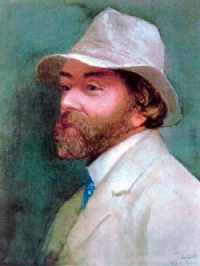
Archibald Knox (09 April 1864 – 22 February 1933) was a Manx artist and designer born at Cronkbourne near Tromode, Isle of Man (Manx: Mannin). He is now associated with the art nouveau movement that flourished throughout Europe and the United States during the late 19th and early 20th centuries. However, his work spanned the Arts and Crafts Movement, Celtic Revival, Art Nouveau, and Modernism. His designs are noted for having been informed by his Celtic roots. Archibald Knox drew his inspiration from the landscape and the carvings on the Celtic and Norse crosses, stones and monuments that he had seen on his native Isle of Man. In 1893 The Builder published an article by Archibald Knox with the title, 'Ancient Crosses in the Isle of Man'.
His designs complemented those prevalent in the art nouveau movement, much of which was also heavily influenced by natural structures and forms. Art Nouveau was seen as both a style and philosophy that drew inspiration from the natural world rather than looking back into history and recreating historical styles. It was heavily influenced by the Arts and Crafts movement which sought to promote handicraft and skilled workmanship at a time when industrialisation was seen to be debasing the work of skilled artisans through the process of mass production. The Art Nouveau movement encompassed all aspects of art, design and architecture and was developed by a generation of skilled and energetic designers and artists who sought to advance an art form appropriate to the modern age.